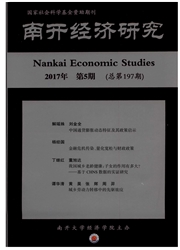

 中文摘要:
中文摘要:
本文构建了一个包含政府财政消费性支出和生产性支出的内生增长模型。为刻画政府提供的公共物品的非完全竞争特征,在效用函数和生产函数中分别加入了消费品拥挤因子和生产品拥挤因子,推导了经济增长目标下最优的财政生产性支出规模,并通过数值分析得出财政的生产性支出与经济增长之间存在倒“U”型关系。此外,分时段的实证研究结果表明:2000—2006年政府财政的生产性支出对于经济增长有促进作用,但是在2009—2012年继续增加政府财政的生产性支出对于经济增长却有抑制作用。尤其在东部地区,政府财政支出对于私人投资的挤出效应更为明显,其抑制了该地区经济增长。本文的结论指出政府财政支出一方面要加快从竞争性领域退出,逐渐加大对非竞争性与非盈利性的公共消费性服务品的支出,另一方面也要加大对于拥挤程度较低或者具有完全非竞争性领域的财政支出力度,以保持经济的平稳增长。
 英文摘要:
英文摘要:
This paper establishes an AK economic model with government fiscal consumption expenditure and production expenditure. By inputting the parameter of consumption expenditure's congestion into utility function and the parameter of production expenditure's congestion into production fianction,the paper represents the degree of congestion associated with the public goods. According to the feature of China's economy and the demand of transforming government performance, the paper through theoretical analysis solves the optimal fiscal production expenditure with economic growth and social welfare maximization respectively. The paper is of real significance by analyzing the factors influencing the differences of government's performance driven by economic growth and social welfare maximization. Meanwhile, the paper through numerical analysis demonstrates that the fiscal production expenditure's impact on the economic growth and social welfare can be described in an inverted " U " form. By empirically analyzing the influence of the fiscal production expenditure on the economic growth, we find that the relationship between these two variables is strongly positive in the period of 2000--2006, but negative in the period of 2009-2012. Especially in the eastern region,the fiscal production expenditure is crowding out private investment so as to restrain the economic growth. As a conclusion, the paper provides policy suggestions of reducing the scale and improving the efficiency of fiscal expenditure, maintaining rapid economic growth through optimal fiscal production expenditure and maximizing economic growth and social welfare through optimal fiscal consumption expenditure.
 同期刊论文项目
同期刊论文项目
 同项目期刊论文
同项目期刊论文
 期刊信息
期刊信息
